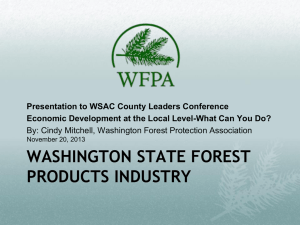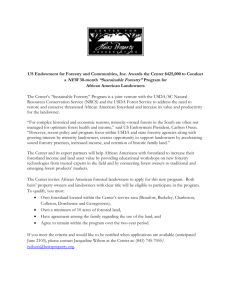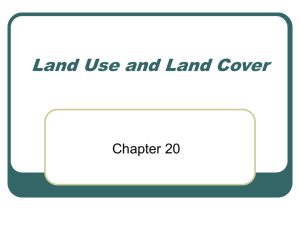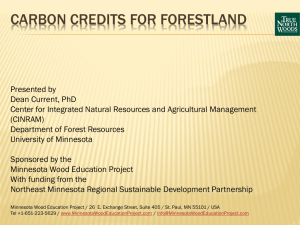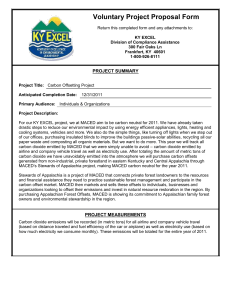re as of Proiections
advertisement
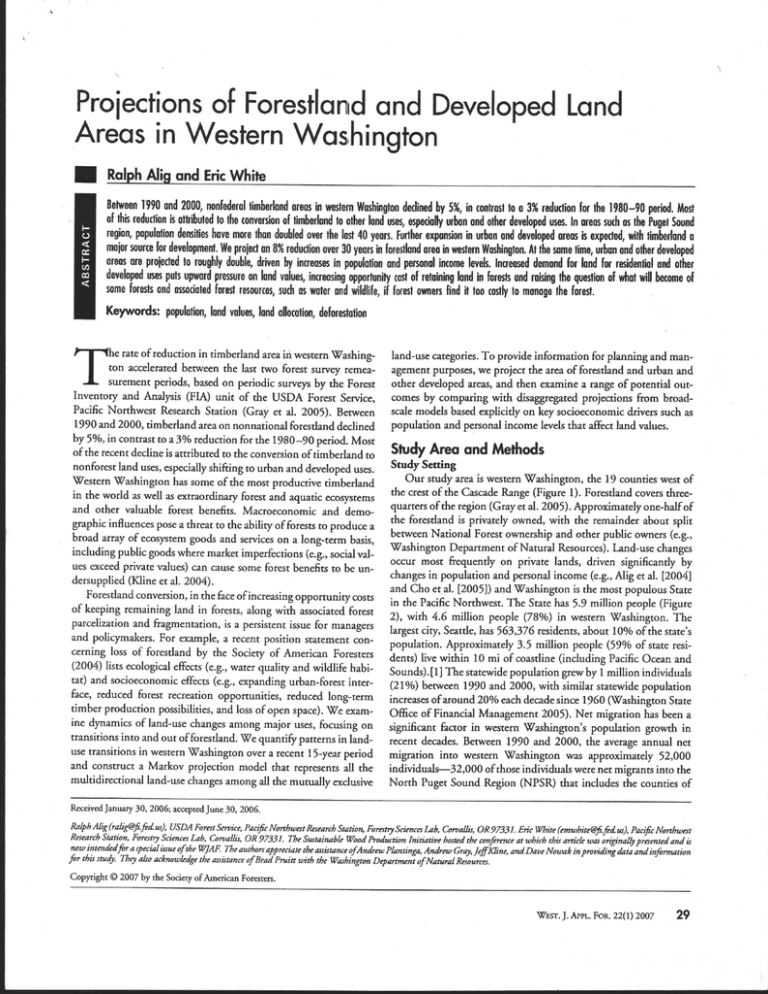
Proiections of Forestlanld and ~ e v e l o ~ eLand d in Western Washington re as Ralph Alig and Eric White Between 1990 and 2000, nonfederol timberland orem in wegem Washington declined by 5%, in tontrml to a 3% reduciion for the 1980-90 period. Most of this reduction is attributed to the conversion of timberland io ofher lond uses, especially urban and other developed uses. In areas such os the Puget Sound region, population densities hove more than doubled over the lmt 40 yeon. Further expansion in urban and developed areas is expected, with timberland o mojor source for development.We project an 8% reduction over 30 yeon in fwertlond area in western Washington. At the m e time, urbon rind oiher developed and personal income levels. Increased demand for land for residential and other areas ore projected to roughly double, driven by increuses in developed uses puts upwurd pressure on lond volues, increasing opportunity cast of retaining lond in forests and raising the question of what will become of some forests and aaotiated farest resources, such m woter and wildlife, if forest owners find if too costly to rnmoje the forest. Keywords: population, lond values, land allocation, deforestation T he rate of reduction in timberland area in western Washington accelerated between the last two forest survey remeasurement periods, based on periodic surveys by the Forest Inventory and Analysis (FIA) unit of the USDA Forest Service, Pacific Northwest Research Station (Gray et al. 2005). Between 1990 and 2000, timberland area on nonnational forestland declined by 5%, in contrast to a 3% reduction for the 1980-90 period. Most of the recent decline is attributed to the conversion of timberland to nonforest land uses, especially shifiing to urban and developed uses. Western Washington has some of the most productive timberland in the world as well as extraordinary forest and aquatic ecosystems and other valuable forest benefits. Macroeconomic and demographic influences pose a threat to the ability of forests to produce a broad array of ecosystem goods and services on a long-term basis, including public goods where market imperfections (e.g., social values exceed private values) can cause some forest benefits to be undersupplied (Kline et al. 2004). Forestland conversion,in the face of increasing opportunity costs of keeping remaining land in forests, along with associated forest parcelization and fragmentation, is a persistent issue for managers and policymakers. For example, a recent position statement concerning loss of forestland by the Society of American Foresters (2004) lists ecological effects (e.g., water quality and wildlife habitat) and socioeconomic effects (e.g., expanding urban-forest interface, reduced forest recreation opportunities, reduced long-term timber production possibilities, and loss of open space). We examine dynamics of land-use changes among major uses, focusing on transitions into and out of forestland. We quantify patterns inlanduse transitions in western Washington over a recent 15-year period and construct a Markov projection model that represents all the multidirectional land-use changes among all the mutually exclusive - p p land-use categories. To provide information for planning and management purposes, we project the area of forestland and urban and other developed areas, and then examine a range of potential outcomes by comparing with disaggregated projections from broadscale models based explicitly on key socioeconomic drivers such as population and personal income levels that affect land values. Study Area and Methods Study Setting Our study area is western Washington, the 19 counties west of the crest of the Cascade Range (Figure 1). Forestland covers threequarters of the region (Gray et al. 2005). Approximatelyone-half of the forestland is privately owned, with the remainder about split between National Forest ownership and other public owners (e.g., Washington Department of Natural Resources). Land-use changes occur most frequently on private lands, driven significantly by changes in population and personal income (e.g., Alig et al. [2004] and Cho et al. [2005]) and Washington is the most populous State in the Pacific Northwest. The State has 5.9 million people (Figure 2), with 4.6 million people (78%) in western Washington. The largest city, Seattle, has 563,376 residents, about 10% of the state's population. Approximately 3.5 million people (59% of state residents) live within 10 mi of coastline (including Pacific Ocean and Sounds).[l] The statewide population grew by 1 million individuals (21%) between 1990 and 2000, with similar statewide population increases of around 20% each decade since 1960 (Washington State Office of Financial Management 2005). Net migration has been a significant hctor in western Washington's population growth in recent decades. Between 1990 and 2000, the average annual net migration into western Washington was approximately 52,000 individual+32,000 of those individuals were net migrants into the North Puget Sound Region (NPSR) that includes the counties of ~ Received January 30,2006; accepted June 30, 2006. Ralph /Ilig(rab@f;.f2dus), USDA F m t S m i t e , ZJmjic Northw~stResearch Station, Foremy Scienc~sLab,Car&, OR97331. Eric Whitc (cmwhite@$.f;dur), Panfir N o r t h s t Research Station, Fore* Scimrcs Lab, G w a l b , OR 97331. Tbr SmuiMbIr W d Rwtulion Initiatee head thc conj&nceat which this article wm origina&presentedand L now inienakdfi a speciaIinueofthe WM.The~uthorsappectethe assistance ofAndrew Phtinga, AnAndtw Gray,JefMint, andDave Nowak inpmvidingdzta andinfirmarion $r this stu4. They alro acknowledge the rlssistatfceof Brad Pnritt with the WashingtonDrpmtmmt of Natural Resoune~. Copyright O 2007 by the Society of American Foresters. Figure 1. Housi d ~mn-onT20031.) density in weJtwn Washington by census Mock group. (Doh sources USDC Census Bureau[U)051and Washington State Deporhnent (USDA Natural Resources Conservation Service [NRCS] 2000). Nonfederal forestland area was reduced by 313,000 ac or 4% between 1982 and 1997. Figure 2. Washi State population, forest area, and per capita forest area, 1900-2000ab sources:USDC Census Bureau 120011and Smith et al. [20041.) King (with Seattle), Skagit, Snohomish, and Whatcom Washington State Office of Financial Management 2005). The highest household incomes are concentrated around the Seattle to Olympia corridor and around Vancouver in Clark County just north of Portland, Oregon, areas ofwestern Washington that have had relatively large expansions in developed areas in recent decades. The percentage of western Washington that is developed is 6%. The percentage of developed land (18%) within the NPSR is much higher, reflecting the influence of the Seattle metropolitan area. Land supply for housing in the NPSR is squeezed between the Puget Sound to the west and the Cascade Mountains to the east, which are dominated by public land. Development has spread in a northsouth corridor. Housing density is higher than average along the entire length of Interstate 5 (Figure 1). High housing densities and development "inland" from Interstate 5 generally are associated with major transportation routes. Such areas near these major roads experienced increased development when western Washington had a 52% increase in area of urban and other developed land benveen 1982 and 1997, with 40% of that increase between 1992 and 1997 Estimation of Land-UseTransition Probabilities and Comparison of Land Values The FIA survey reported a net reduction in timberland area (Gray et al. 2005), and we examined data from the USDA NRCS's ~ a t i b n aResource l Inventory (NRI; 2000) to quantify pathways of changes among major land-use classes.[2] Using the NRI data, we estimated periodic transitions among seven land coverluse classes-forestland, cropland, pastureland, rangeland, urban and developed uses, Conservation Reserve Program land, and miscdaneous uses-to determine the major sinks for forestland that was converted to other uses and sources of any new foresdand.[3] The NRI land coverluse data were collected every 5 years on the same samples of land fiom 1982 to 1997. We used these periodic data to estimate what percentage of forestland tends to stay in forest over a specified time period and the percentages of forestland transitioning to the other six NRI land coverluse classes. A first-order Markov model (e.g., Alig and Wyant [1985]) was used to represent the land coverluse change data for several reasons. First, land coverluse change is not unidirectional and a given parcel of land may change from one category of land wverluse to any of the other six. In our Markovian analysis, we use matrices that represent all the multidirectional land coverluse changes among all the mutually exclusive land coverluse categories. With the seven land coverluse categories, there are 42 possible different land covertuse changes for each discrete time period, which are incorporated into a 49-cell transition matrix (with seven on-the-diagonal "no-change" cells). Relatively low or zero probabilities reflect that some land covertuse changes are not likely, such as transitions out of the urban and developed category. We used the NRI-based percentages in a Markov model of land covertuse to simulate transitions among different major land coverluses over a 30-year projection period for both western Washington and the NPSR We compared the relative size of urban versus forestry net returns to provide broad indicators of relative rankings of land uses within an economic hierarchy of land use. Land has a current market value equal to the net present value of expected benefits in excess of costs. Increased demand for residential and other uses of developed land in some areas has outweighed those for timberland in recent decades. If conversion of forestland to development is influenced significantly in many cases by location, this could mean that private forest use may be pushed more toward hinterlands at an increasing distance fiom metropolitan areas. Forestland values reflect current as well as anticipated uses of land. Forestland prices anticipate hture development dose to urbanizing areas. Urban returns were estimated as the median value of a recently developed I-ac parcel used for a single-family home, less the d u e of structures (Lubowski et al. 2006). Net returns per acre from forestry were estimated by the net present d u e of weighted sawtimber revenues from di&rent forest types, where a series of timber harvests occur at an economically optimal (Faustman) rotation for a 5% interest rate. Projectkg Futnre Nonfeded Forestland Area We projected the area of nonfederal forestland (as well as the other major land coverluses) in western Washington and the NPSR to 2027 (two 15-year periods fiom 1997) using the Markovian transition probabilities constructed from the coreset of NRI data for western Washington and the NPSR. The 1997 NRI estimates of acreage in seven land coversluses or initial states served as the projection starting points.[4] Then, we examined possible outcomes based on (1) use o f N N as compared with FIA historical data and (2) consideration of the influence of socioeconomic variables on hture forest area. In the first case, we compared our projections based on NRI data analyses to those if the trend in forest area based on FIA survey findings (Gray et al. 2005) was extrapolated for 30 years. In the second case, we disaggregated projections from earlier land-use models that incorporated socioeconomic drivers such as population and personal income levels. We obtained such projections for western Washington and the NPSR from a national-level model (dig and Planting 2004) and from the Western Washington Timber Supply Study (Adams et al. 1994). Alig and Plantinga (2004) used an economic model of revealed behavior to project land use nationally to the year 2030, with population and personal income levels as key determinants of changes in land use. [5] From this national-level model, we extracted the land-use projections for counties within western Washington and the NPSR. We then did likewise with forest area projections from the Western Washington Timber Supply Study (Adams et al. 1994, Parks and Murray 1994), which were based on physical attributes of the land resource, stumpage values, agriculture returns, and changes in population. Projecting Future Urban and Developed Areas We examined potential outcomes involving urban area projections for western Washington and the NPSR by following the general approach in projecting forestland areas, except that there are no FIA data on developed areas that we could extrapolate when looking at a range of potential outcomes. Instead, we compared our urban and developed area projections, based on the Markovian transition Table 1. Lond cover/use transition probabilities for western Washington (15-yr period). Crop Pasture Form Urban Other Fom Urban Crop Pasture 68.9% 8.2% 0.0% 0.0% 0.0% 14.4% 0.4% 10.4% 6.0% 74.7% 2.2% I::: 0.4% 95.596 0.0% 100.0% 0.0% 0.0% 0.0% 3.5% 96.5% 0.0% From 1982 land coverluse 4 Other i: To1337 landcOverluse 1 Besed on the 1982 and 1997 NRI &n. matrices described previously, to urban and other developed area projections from four other studies. We investigated one potential outcome associated with socioeconomic factors by disaggregating the developed area projections from the same national-level economic model by Alig and Plantinga (2004) used in the forestland area projections. Then, we examined three other potential outcomes for developed land area by drawing on national-level studies that focused on developed land: Alig et al. (2004), Nowak and Walton (2005), and Theobald (2005). In the first national-level study, Alig et al. (2004) projected developed areas (based on NRI data) using an econometric model incorporating population density, per capita income, proximity to metropolitan areas, and the d u e of agricultural products. In the second study, Nowak and Walton (2005) projected future urban areas based on recent national-level urban area growth races (from USDC Census Bureau data) that varied depending on urban area size. Last, Theobald (2005) constructed a simulation model ofhousing unit density using USDC Census Bureau data, incorporating county-level population projections, number of housing units per 1,000 people, recent housing density growth rates, and travel time to the nearest urban core. - Results Land Use Transition Probabilities Land in western Washington that was forested in 1982 generally remained as forest in 1997, according to NRI data. There was a 95.5% probability that forestland in 1982 remained forested in 1997 (Table 1).When forestland did transition to some other land use, forestland was most likely to transition to urban and built-up uses. There was a 3.1% probability that forestland in 198.2 would transition to urban and built-up uses by 1997. In contrast, the probability of transition from cropland to urban and built-up land during the same period was 10.4%. Pastureland (2.2%) and cropland (0.4%) were the only land coversluses that had a likelihood of transitioning to forestland during the 15-year period. As expected, there was a 100% probability that land dassified as urban and built-up in 1982 remained urban and built-up in 1997 in western Washington (Table 1). In addition, there was a positive probability of land transitioning to urban and built-up land from each of the other land coverluse classes in western Washington. Pasture had the greatest probability (12.1%) of transitioning to urban and built-up land during the 1982-97 period (Table 1). Forestland in the NPSR region was less likely to remain forested between 1982 and 1997 than forestland in western Washington in general. Within the NPSR, there was a 93.1% probability that forestland in 1982 would remain forested in 1997 (Table 2). Similar to the general pattern in western Washington, if forestland within the NPSR transitioned during the period, it was most likely to become urban and built-up. During the 15-year period, the probability of r a b 2. cover/vse trallSitiOn Washington (15yr period). GOD Pasture Cmp Pasnrre Fom Urban Other 73.3% 10.9% 0.0% 0.0% 0.0% Forest 9.1% 68.5% probabiri for Urban -- - -..- - - - .-... - - . - -. - -. ... . . -- -- I I a= '- I Other 0.0% 9.8% 7.9% 2.0% 0.4% 93.1% 0.0% 0.0% 100.0% 0.0% 0.0% 0.0% 4.3% 95.7% From 1982 land coverluse -i ' NPSR 05 :::; ;/ / - - c ~ l i g and Platdhga / land .1 Basal on rhc 1982 and 1997 NRI dara. I I Year I Figure 4. Pmiected forniland area (1997,100%) o m 30 yean in w s t em Washington with h e Markoviun model (hunsition matrices) and alter~8lO-lM)s~m im5-10acm la1 - s a w s ' L native pro+ctions. Q c 1 acre Figure 3. Variation in price of undeveloped land parcels in relation to distance nlnterstaie 5 and size of parcel, hhomish County, Washington. 1 forestland transitioning to urban and built-up was 5.6%. Similar to all ofwestern Washington, NPSR pastureland was the major source of land tran~itionin~ t i forest use (2.0%). Pastureland and cropland within the NPSR were the land uses most likely to transition to urban and built-up land during the 1982-97 period, 16.7 and 9.8%, respectively (Table 2). Land Value Dierences between Forest Use and Developed Uses For 38 counties in the Pacific Northwest west of the crest of the Cascade Range, including the 19 counties in western Washington, per acre values are $1,438 in forest use and $165,947 in urban use. In looking at influence of parcel size (using l-ac size for parcels for single-family homes), land values per acre for 1- to 5-ac tracts are more than 40 times higher than for tracts larger than 100 ac in Snohomish County, Washington.[6] This influences the competitive position of forestry versus developed uses in interface areas such as urbanizing locations, tending to push forestry further out from metropolitan areas. Location of parcels near major transportation routes also can affect land values. Figure 3 indicates that undeveloped parcels closer to Interstate 5 in Snohomish County, Washington, tend to have higher prices than those parcels more distant, in addition to the upward pressure on parcel price as size of the parcel becomes smaller. For example, the highest land prices for undeveloped parcels (more than $400,0001ac) are those for such parcels within 5 mi of Interstate 5 and in the parcel size class of less than 1 ac. Forestland Area Projections We project an 8% reduction in forestland area in western Washington from 1997 to 2027 (Figure 4), based on simulations using the land-use transition probabilities that we estimated from the NRI data. Although some fbrestland was gained as result of transition I 1965 a005 2015 2325 Year Figure 5. P r a j e d forerrland area (1997, 100%) over 30 30 in the poiecNPSR wihhkwian model ( M n s l m mwim) and tions. from pastureland and cropland to forestland, this was not enough to offset the transition of forestland to urban and developed uses. Seventy percent of the forestland area that is projected to transition from forest to another land coverluse is expected to ultimately become urban and built-up land. Approximately 20% of transitioning forestland is expected to become rural infrastructure land or other miscellaneous land uses. Most of the remainder of transitioning forestland (9%) is projected to become pastureland. We project the NPSR forestland area to decrease by 13% between 1997 and 2027 (Figure 5), based on Markovian simulations using the NRI-based transition probabilities. We project that 80% of forestland transitioning to another use in the NPSR becomes urban and built-up land-a greater percentage than for western Washington in general. Approximately 15% of transitioning forestland is projected to become rural infrastructure or other miscellaneous land uses, with the remainder of transitioning forestland projected to become pastureland. Based on the diiaggregated results obtained from the economic model of Mi and Plantinga (2004),forestland area in western Washington is projected to decrease 13% between 1997and 2025 (Figure4). For the NPSR, the projections with the economic model by Alig and Plantinga (2004) indicate a 22% reduction in forestland area between 1997 and 2025 (Figure 5). Using resul~from the model used originally in the Western W a s h i i o n Timber Supply Study (Adamset al. 1994), forestland area in western Washington is projected to decline by 4% between 1997 and 2025 (Figure 4). Using the same approach, a 7% account for larger lot size in rural areas. Projections of increases in the urban area component by Theobald's (2005) and Nowak and Walton's (2005) models are nearly identical at around 60%. +Tmns~Iron I +AHg and olhers I-i-_Nowak-Theobeldand Waflon 14046 - matiices 100% 8096 -- 60% 40% 1986 2005 2015 2025 Year FQUE6. R o ' iurban or dedopd land 11997,100%)over 30 years with Ihe Morkovicln modd Ifmnsitionmcltricesl in western Washinaton and Figure 7. Projected urban or devdoped a m (1 997,100W over 30years in he NPSR with the Markovian modd [transition matrices) and ahwMltive proiections. reduction in foresrland area is projected fbr the NPSR over the same period (Figure 5). Urban and Developed Area Projections We project urban and developed areas of western Washington to increase substantially over the next several decades (Figure 6), based on our core set of NRI transition probabilities used in the Markovian model. Our projections indicate a substantial expansion in developed area, similar to outcomes obtained by disaggregating results from the national-level economic models of Alig et al. (2004) and Alig and Plantinga (2004). AU three projections indicate that urban and built-up area may approximately double between 1997 and the middle of decade 2020. . Comparatively, the next group of projections by Theobald (2005) and Nowak and Walton (2005) is restricted to urban area coverage. Results from those two models indicate increases of 60-70% in urban area by 2025 for western Washington.[7] The range of projection outcomes for increases in urban and built-up area in the NPSRis similar in magnitude to that for western Washington in general. For the broader coverage case of urban and built-up area, the range in projected percentage increases is between 190 and 240% (from the respective study's starting point; Figure 7). The largest increase in urban and developed area is projected by the Alig et al. (2004) model (Figure 71, which also includes rural built-up areas. Large lot sizes associated with rural residential areas occur more frequently in rural areas than urban areas, with land in rural areas generally less expensive than in urban areas, which may Discussion Commonalities for the alternative projections indude the importance of an expanding populauon as a key socioeconomic driver of an increasing area of developed uses and reduced forestland area. Broadly, population increases boost demand for land as home sites, roads, parks, airports, schools, commercial and industrial space, other developed uses, and open space to satisfy the demands of urbanized areas. The population increase arises both inside and outside the state because natural amenities and job opportunities influence migration patterns of some individuals to ruralareas (e.g., McGranahan [1999]). Between 1995 and 2000, Washington was the destination for the largest outflow of people moving fiom four states: Oregon, Idaho, Alaska, and Montana. Increases in personal income also fuel demands for developed land, with the counties experiencing the highest rate of development being those with the largest per capita income levels in western Washington. Further substantial urbanization and other development in western Washington is likely in the face of the projected population and income levels, with some coming from forestland. The growth in urban and built-up area under the alternative projections continues to exceed . , that for population, as an approximately 50% increase in western Washington's population by 2030 is projected to contribute to a more than do;bing of urban and built-up area. Although Washington is expected to have above-average population growth, between 1982 and 1997 the Pacific Northwest region added area for each additional resident that was below that for other fast-growing regions such as the South (Alig et al. 2004). How Washington's population is distributed across space will be affected by the use of urban growth boundaries that identify boundaries for expected new urban development (Washington State Department of Community, Trade, and Economic Development 2003). The largest amount of developed area is projected with a model that gives more weight to more recent observations on land-use changes. The Alig and Plantinga (2004) model uses data fiom the 1992 to 1997 NRI remeasurement period, resulting in projections of a 13% reduction in private forestland area in western Washington over 30 years. The 13% reduction is similar to a 15% reduction that would result if the FLA. decadal rate of reduction due to land-use changes, based also on 1990s data, was simply extrapolated for 30 y e a r s r ~ h e nNRI land-use data are used from the longer time period of 1982 to 1997, an 8% reduction is projected. The model based on the 1992-97 datareflects more stronglythe higher level of economic activity in the 1990s, including stock marker advances that boosted overall personal income levels. The FIA data (Gray et al. 2005) also showed an acceleration in timberland area reduction in the 1990s compared to the 1980s, including for the NPSR that has forested watersheds projected to experience increased housing development on more than 20% of a watershed's area (Stein et al. 2005). In particular, the watershed projected to undergo a "high level" of housing density increase is located within the NPSR in Whatcom and Skagit Counties. Substantial shifting of rural lands to developed uses is projected to continue and, broadly speaking, prospective returns to forestry enterprises generally are not significant deterrents to some land development (Parks and Murray 1994, Alig et al. 2004). Lubowski (2002) indicated that increases in urban areas were largely unaffected by changes in net returns to nonurban uses, such as agriculture. This is consistent with the large differentials between land values for dweloped uses in contrast to those in forest use noted in this study, including the important influence of location, e.g., proximity to interstate highways and Seattle. Haynes (2005) suggests that in the past forestland owners in the region have relied on sustained upward changes in timber prices to provide incentives to increase the extent of umber management prices, but that such owners now face a future of relatively stable timber prices, raising questions about whether market incentives will be sufficient to promote sustainable forest management. If markets are not likely to promote conservation offorestland, Cho et al. (2005) point out that forestry zoning rends to reduce fbrestland loss but it shifts development to farmland. Conversely, agricultural zoning shifts development from farmland to forestland. This finding points to the importance of considering all land uses when deliberating policies and recognizing interconnections between forest and agricultural land uses on the fixed land base. The possibility of spillovers between regions with different land-use zoning or regulations is reflected in the case of Clark County, Washington, in which its growth in part has been fueled by many people who commute to work in Portland, Oregon, while living in Washington. Conclusions Findings from periodic forest surveys and land-use change research are Long-term trends in forestland and timberland areas in western Washington are downward, with the region losing more than one-half million ac of timberland since 1980. Per capita amount of forestland in Washington is less than one-third of the 1940 level. In recent years, a large majority of converted forestland in western Washington has been dweloped versus shifted to agriculture. Population densities have more than doubled between 1960 and 2000, and the area of developed land increased by 52% between 1982 and 1997, while the much larger forestland area decreased by 4%. The probability that 1982 forestland would remain forested in 1997 was 95.5%. Most forestland conversion has been on nonindustrial private forestland, which often is important in riparian zones. Between 1982 and 1997, the largest source of new forestland was pastureland, followed by cropland. At the same time, the piobability of conversion of forests to urban and developed uses was 3.1%, resulting in a net loss of forestland. Land values for dweloped uses can be 80 -1 00 times larger than that for forestland. Land values for undeveloped parcels tend to increase as distance decreases to Interstate 5 and as parcel size decreases. Washington's population is projected to increase by more than one-third over the next 25 years. The amount of developed area per new person in the region has increased over time, with urban and built-up area growing faster than the population. We project an 8% net reduction in forestland area in western Washington for the 30-year period between 1997 and 2027. At the same time, area of urban and developed area is projected to approximately double. Projections based on information from different studies and data sources (e.g., USDA's NRI, USDC Census) are reasonably consistent; however, length of historical data series does affect projection results because the 1990s exhibited more economic growth than the 1980s. Monitoring land-use changes, including the rural residential component, would aid in better understanding of hctors that affect land use, impact forest management, and increasingly complicate efforts to promote sustainability of some forest ecosystems. Periodic land base assessmentscould aid policymakers hced with permanent loss of forestland and how that might be altered with thoughtful land-use policies and economic incentives to own and manage forestland (Society ofAmerican Foresters 2004). With more than 120 million people projected to be added to the US population over the next 50 years, increased relative demand for land for developed uses is likely-to change the area of productive working forests and the provision of public goods by forests, such as open space and the environmentalservice of storing more terrestrial carbon to mitigate climate change. Endnotes [I] Based on geographic information sysrem analysis using Census Block group geographic centroids. 121 Technical details on the NRI data are described in a longer report that can be obrained from the authors of this arricle and a summaryof NRI survey methods and definitions are given also by Mig et al. (2004). [3] Only about 2% of private forestland in western Washington is not clasiied as e use mtal timberland area as a reasonable timberland. Thus, in the a ~ d we approximation for forestland area when discussingalternativesets of projections. [4] No acrs within wesrern Washiion or the NPSR were classified as Conservation Resetve Program (CRP) land or rangeland in either rhe 1982 or the 1997 NRI data 151 Theland-w model was applied in the 2005 Resources PlanningAct Assessment and is a national-level econometric model (Iubowski 2002, Lubowski et al. 2006). The model is based on private land-use decisions depending on anticipared economic returns to alternative land uses, and Lubowski et d. (2006) provide information on model coeffiaenrs and elasticities. [6] We excluded residential land and commercial land, including any parcels thar had any value from improvemenu. The landvalue esrimatesare basedon the sale price from transactions in conrrast to values carried on rax assessment records. [7] Theobald (2005) excluded indusvid and commercial areas in the use of Census dam, and Nowak and Walton (2005) also used Census definitions of urban area. The other studies(e.g.,Aligand Manringa [20041) used NRI sunreyesirnates for the broader group of urban and builr-up areas. Literature Cited AUAMS,D.M., RJ. AWG, AND J. SEVENS. 1994. An analysis of furure softwood timber supply in western Washington. Wnt./. Appl For. 9(3):81-87. ALIG,RJ., ANDJ.G. WYANT.1985. Projecting regional area changes in forestland cover in the U.SA Ecol. Model. 29:27-34. A I . ~ ,RJ., AND k J . PIANTINGA. 2004. l~unrrefordand area: h p a m from population growth and other factors thar affect 1andvalues.J For. 102(8):19-24. ALIG, RJ., J.D. KLINE, AND M. L I C H T E N2004. S T ~ Urbanization . on the US landscape: looking ahead in rhe 21st century. L a d c . Urb. Pkn. 69(2/3):219-234. CHO, S.H.,J. WU,AND R ALIG. 2005. Land development under regulation: Comparison benveen the east and west sides of the Cascade Range in Oregon, Washington, and California. Rev. Urb. Reg. Dm.S d 17(1):1-17. GRAY, AN., C.F.V~WIUASE, AND RD. RHOADS.2005. Timber nsoutre stmisticsjGr 22W USDA For. Serv. Res. Bull. nonw'onalfirst kndin w s m Wakingtov~, PNW-RB-246.117 p. HAYNES, R 2005. Will markers provide sufficient incenrives for suminable Forest management? Chap. 3. P. 13-19 in Undmtandmg kbry iaKs of su&inabIc wood proddon in tbe Pacrfic Norrhumt. USDA For. Sew. PNW-GTR-626, Pacific Northwest Research Sration, Portland, O R 67 p. KIJNE, J.D., R.J. ALIG,AND B. GARBER-YONTS. 2004. Forestland social dues and open space preservation./. For. 102(8):39-45. L,UROWSKI, RN. 2002. Determinants of kznd-we transitions in the United Skltcs: Econometric analysis of cbmga mnong thc majm M - u c r categorin. PhD dissertation, H m d Univ., Cambridge, Mk 266 p. AND RN. STAVINS. 2006. Land-use change and LUBOWSKI, RN., A.J. PLANTINGA, carbon sinks: Economeuic estimation of rhe carbon sequestration supply funmion./. Envim. Ecm. Mamge. 51(2):135-152. MCGRANAHAN, DA. 1999. Natural amrnik drive rural populbtion change. A g r i c u l d Economic Rep. AER781. Available online at www.ers. usda.govlPublicatiomIAER781I; last accessed Occ 4.2006. . NOWAK, D.J., ANDJ.T. WAITON.2005. P m j d urban g r o h (2000-2050) and its estimated impact on the US forest resource.J. For. 103(8):38%389. 1994. Land arrributes and land allocation: PARKS,P.J., AND B.C. MURRAY. Nonindustrial forest use in the Pacific Northwest. For. Sci.40(3):558-575. SOCEIT OF AMMICAN FOIWTERS (SAF). 2004. Loss of fbrat &ad A position statement of thp So+ of Amm'ran Fomten. Available online at www.safnec orglpolicyandprgs/psst/loss-oLforestI1and.chn;last accessed Ocr. 4, 2006. AND S. PUGH.2004. Forat mources oftbc Unircd SMITH,W.. P.MILES, J. VISSAGE, Stat&, 2002. USDA For. Sew. Gen. Tech. Rep. NC-241, North Central Research Stadon, St. Paul, MN. 137 p. RJ. k c , M.D. NELSON,D.M. T H ~ B A UM.) , STFJN,S., RE. MCROBERTS, DECI-ITAR, AND M. CARU.2005. Foresir on rhc edge: Housing drwlopment on MCII 5private16mn.USDA For. Ser. Gen. Tech. Rep. PNW-GTRa36.16 p. '~HWRALD,D.M. 2005. I d c a p e p a t t ~ of~~llrbangrolutb in tbe USAfrom 1980 to 2020. b l o g y and society. Available on-linr at www.eu,Icgyandsociety. org/~0ll0/issllard2lastanessad Oct. 4,2006. RFSOURCE CONSERVATION SERVICE AND IOWASTATE UNIVERSITY USDA NATURAL ST~llSnClu~BoRAToRY.2000. Sumtnay rrpmt: 1997 natural raourca mmwty ( d DKnnbm 2000). AAvailable online at www.nrcs.usda.gov/ mh~ca~~RI/1397/swnmary~reporr/report.pdf; last accessed O m 4,2006. USDC CENSUSBUREAU.2001. S t n & k [ a b s n ~ ~ f f hUniredSkZtc~, e 22W Available online .at www.ccnsus.govlprodl2002puhs/ OlsfatahI stat-ab0l.hrml; last accased Oct 4,2006. USDC CENSUSBUREAU.2005. H m n g lmio by muw b h k p p , c m 2000. Generated by E. White using American Facdinder. Available online at www.facrfinder.wnsus.gov;last a d O a . 4, 2006. WASHINGION STATEDEPARTMENT OF COMMUNITY. TRADE, AND ECONOMIC DEVFIOPMFNT. 2003. G r d managrmrnt: Qupmonr and annum. Available online at www.cad.~govIICTEDIdownen~IIDD1069~ Publications.pdf; last a d Ocr. 4,2006. OF TRANSPORTATION. 2003. Wmhngon State WASHINGTON STATEDEPARTMENT H i g h , 2003. GIs &m Available online at www.wsdot. wa.gov/ mapsdara/geodaracaralos/~r.hun;last accessed Oct. 4,2006. WASHINGTON S T AOFFICE ~ OF FINANCIAI. MANAGEMENT. 2005.2005populmia &. Annual report, Washington State Oflice of Financial Management, Forecasting Division, Olympia, WA. 54 p.
